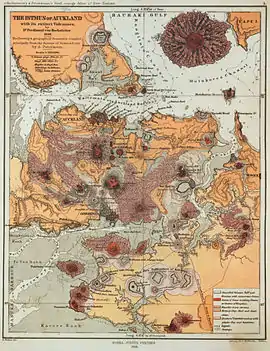Ferdinand von Hochstetter
Christian Gottlieb Ferdinand Ritter von Hochstetter (30 April 1829 – 18 July 1884) was a German-Austrian geologist.


Biography
He was born at Esslingen, Württemberg, the son of Christian Ferdinand Friedrich Hochstetter (1787-1860), a clergyman and professor at Bonn, who was also a botanist and mineralogist. Having received his early education at the evangelical seminary at Maulbronn, Ferdinand proceeded to the University of Tübingen and the Tübinger Stift; there, under Friedrich August von Quenstedt, the interest he already felt in geology became permanently fixed, and he obtained his doctor's degree and a travelling scholarship.
In 1852 he joined the staff of the Imperial Geological Survey of Austria and was engaged until 1856 in parts of Bohemia, especially in the Bohemian Forest, and in the Fichtel Hills and Karlsbad mountains. His excellent reports established his reputation. Thus he came to be chosen as geologist to the Novara expedition (1857–59), and made numerous valuable observations in the voyage round the world.
In 1859 he was employed by the government of New Zealand to make a first geological survey of the islands. His survey of old Lake Rotomahana and the Pink and White Terraces provides the only primary evidence of the Terrace locations today. Between 2016 and 2020, his survey diary was reverse engineered to provide the coordinates of the Pink, Black and White Terraces.[1][2] [3][4]On his return he was appointed in 1860 professor of mineralogy and geology at the Imperial-Royal Polytechnic Institute in Vienna; from 1874 to 1875 he was the rector there.[5] In 1872 he became the natural history tutor of Rudolf, Crown Prince of Austria.[6] In 1876 he was made superintendent of the Imperial Natural History Museum. In these later years he explored portions of Turkey and eastern Russia, and he published papers on a variety of geological, palaeontological and mineralogical subjects. He died in Oberdöbling near Vienna, at age 55.
Detailed descriptions in his diaries were helpful in 2011, when researchers managed to locate the silica terraces on Lake Rotomahana, which was buried in the 1886 eruption of Mount Tarawera. [7]
Legacy
Taxonomy
New Zealand's endemic Hochstetter's frog, Leiopelma hochstetteri, is named after Ferdinand. Several other species bear his name in their scientific names, including the Takahe, Porphyrio hochstetteri, and Powelliphanta hochstetteri, a species (with five subspecies) of New Zealand's giant carnivorous land snails.
Geography
Hochstetter Peak on Trinity Peninsula in Antarctica is named after Hochstetter,[8] as are New Zealand's Mount Hochstetter (West Coast Region), Lake Hochstetter and the Hochstetter Dome and Hochstetter Icefall close to the Tasman Glacier.[9]
Geology
The rock type dunite was named by Ferdinand von Hochstetter in 1859, after Dun Mountain near Nelson, New Zealand.[10]
Publications
- Karlsbad, seine geognostischen Verhältnisse und seine Quellen (1858)
- Neu-Seeland (1863); published in English as New Zealand: its physical geography, geology, and natural history: with special reference to the results of government expeditions in the provinces of Auckland and Nelson by Dr. Ferdinand von Hochstetter; Translated from the German Original published in 1863 by Edward Sauter... with additions up to 1866 by the author etc. Stuttgart: J.G. Gotta. 1867. Retrieved 20 May 2018 – via Internet Archive.
- Geological and Topographical Atlas of New Zealand (1864)
- The geology of New Zealand: in explanation of the geographical and topographical atlas of New Zealand] (1864)
- Leitfaden der Mineralogie and Geologie (with A Bisching) (1876, ed. 8, 1890).
Notes
Regarding personal names: Ritter is a title, translated approximately as Sir (denoting a Knight), not a first or middle name. There is no equivalent female form.
- Bunn, Rex; Nolden, Sascha (2017-06-07). "Forensic cartography with Hochstetter's 1859 Pink and White Terraces survey: Te Otukapuarangi and Te Tarata". Journal of the Royal Society of New Zealand. 0: 39–56. doi:10.1080/03036758.2017.1329748. ISSN 0303-6758. S2CID 134907436.
- Bunn and Nolden, Rex and Sascha (December 2016). "Te Tarata and Te Otukapuarangi: Reverse engineering Hochstetter's Lake Rotomahana Survey to map the Pink and White Terrace locations". Journal of New Zealand Studies. NS23: 37–53.
- Bunn, A. R., Davies, N. and Stewart, D. (2018) “Dr Hochstetter’s Lost Survey” Surveying+Spatial, 94, 5-13.
- Bunn, A. R. (2019) “Hochstetter’s Survey of the Pink and White Terraces: The Final Iteration” Surveying+Spatial, 99, 30-35.
- "Ferdinand Hochstetter (Geologe)". Wien Geschichte Wiki.
- "Obituary. Dr. Ferdinand von Hochstetter". Geological Magazine. 21: 526–528. 1884. doi:10.1017/s0016756800186066.
- Discovery of silica terraces that was damaged by volcanic eruption
- Hochstetter Peak. SCAR Composite Gazetteer of Antarctica
- Ferdinand von Hochstetter: Father of New Zealand geology, Auckland Libraries. Retrieved 17 June 2017
- Johnston, M. R.; Nineteenth-century observations of the Dun Mountain Ophiolite Belt, Nelson, New Zealand and trans-Tasman correlations, Geological Society, London, Special Publications 2007, v. 287, p. 375-387
References
 This article incorporates text from a publication now in the public domain: Chisholm, Hugh, ed. (1911). "Hochstetter, Ferdinand Christian von". Encyclopædia Britannica. 13 (11th ed.). Cambridge University Press. p. 554.
This article incorporates text from a publication now in the public domain: Chisholm, Hugh, ed. (1911). "Hochstetter, Ferdinand Christian von". Encyclopædia Britannica. 13 (11th ed.). Cambridge University Press. p. 554.
External links
- Fleming, C. A. "Christian Gottlieb Ferdinand von Hochstetter". Dictionary of New Zealand Biography. Ministry for Culture and Heritage. Retrieved 20 June 2017.
- Teara.govt.nz: Te Ara biography of Ferdinand von Hochstetter
- Teara.govt.nz: Te Ara article "Ferdinand von Hochstetter" (1966)
- Michaelorgan.org.au: Ferdinand von Hochstetter and the Austrian Novara Scientific Expedition 1858-9